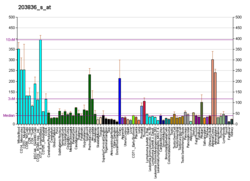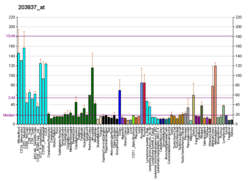MAP3K5
MAP3K5(mitogen-activated protein kinase kinase kinase 5)またはASK1(apoptosis signal-regulating kinase 1)は、MAPキナーゼ経路の一部を構成するMAPキナーゼキナーゼキナーゼである。MAP3K5は、酸化ストレス、小胞体ストレス、カルシウムの流入など一連のストレスに応答して、Raf非依存的にJNKとp38 MAPKを活性化する。MAP3K5は、がん、糖尿病、関節リウマチ、心血管疾患、神経変性疾患に関与していることが知られている[5][6]。
MAP3K5タンパク質をコードするMAP3K5遺伝子は、6番染色体の6q22.33に位置する[7]。ノーザンブロット解析によって、MAP3K5の転写産物はヒトでは心臓と膵臓に豊富に存在することが示されている[8]。
作用機序
[編集]非ストレス状態では、MAP3K5はC末端のコイルドコイルドメイン(CCC)を介してオリゴマー化している(このことは活性化の必要条件である)が、還元型チオレドキシン(Trx)やCIB1の抑制作用によって不活性型となっている[9]。TrxはN末端のコイルドコイルドメイン(NCC)に直接結合することで、MAP3K5のキナーゼ活性を阻害している。TrxとCIB1は、それぞれ酸化還元状態、カルシウム感受的な形でMAP3K5の活性化を調節している。どちらもMAP3K5の活性化因子であるTRAF2と競合しているようである。TRAF2とTRAF6はMAP3K5へリクルートされ、より大きな分子量の複合体を形成する[10]。その後、MAP3K5はCCCだけでなくNCCも介したホモオリゴマー相互作用を形成し、スレオニン845番の自己リン酸化によって完全に活性化される[11]。
MAP3K5遺伝子の転写はIL-1やTNF-αなどの炎症性サイトカインによって、NF-κBタンパク質RelAの活性化を介して誘導される[6]。TNF-αは、MAP3K5タンパク質を脱ユビキチン化によって安定化することもできる[12]。このように、MAP3K5の発現は転写段階だけでなく、翻訳後段階でも調節されている[6]。
相互作用
[編集]MAP3K5は次に挙げる因子と相互作用することが示されている。
研究
[編集]MAP3K5は筋萎縮性側索硬化症(ALS)の治療標的の1つとなる可能性がある。MAP3K5は家族性ALSと孤発性ALSの双方でアップレギュレーションされていることがAIを活用した生物学的標的発見プラットフォームを用いて発見された。標的の発見に伴って、ALSの治療のためにいくつかの経路の解析や薬剤の設計が行われている[28]。
出典
[編集]- ^ a b c GRCh38: Ensembl release 89: ENSG00000197442 - Ensembl, May 2017
- ^ a b c GRCm38: Ensembl release 89: ENSMUSG00000071369 - Ensembl, May 2017
- ^ Human PubMed Reference:
- ^ Mouse PubMed Reference:
- ^ “The roles of ASK family proteins in stress responses and diseases”. Cell Communication and Signaling 7: 9. (April 2009). doi:10.1186/1478-811X-7-9. PMC 2685135. PMID 19389260.
- ^ a b c “Regulation and function of apoptosis signal-regulating kinase 1 in rheumatoid arthritis”. Biochemical Pharmacology 151: 282–290. (May 2018). doi:10.1016/j.bcp.2018.01.041. PMID 29408488.
- ^ “Chromosomal localization of four MAPK signaling cascade genes: MEK1, MEK3, MEK4 and MEKK5”. Cytogenetics and Cell Genetics 78 (3–4): 301–3. (1997). doi:10.1159/000134677. PMID 9465908.
- ^ “Entrez Gene: MAP3K5 mitogen-activated protein kinase kinase kinase 5”. 2022年11月19日閲覧。
- ^ “CIB1 functions as a Ca(2+)-sensitive modulator of stress-induced signaling by targeting ASK1”. Proceedings of the National Academy of Sciences of the United States of America 106 (41): 17389–94. (October 2009). Bibcode: 2009PNAS..10617389Y. doi:10.1073/pnas.0812259106. PMC 2762684. PMID 19805025.
- ^ “Recruitment of tumor necrosis factor receptor-associated factor family proteins to apoptosis signal-regulating kinase 1 signalosome is essential for oxidative stress-induced cell death”. The Journal of Biological Chemistry 280 (44): 37033–40. (November 2005). doi:10.1074/jbc.M506771200. PMID 16129676.
- ^ “Thioredoxin and TRAF family proteins regulate reactive oxygen species-dependent activation of ASK1 through reciprocal modulation of the N-terminal homophilic interaction of ASK1”. Molecular and Cellular Biology 27 (23): 8152–63. (December 2007). doi:10.1128/MCB.00227-07. PMC 2169188. PMID 17724081.
- ^ “SOCS1 inhibits tumor necrosis factor-induced activation of ASK1-JNK inflammatory signaling by mediating ASK1 degradation”. The Journal of Biological Chemistry 281 (9): 5559–66. (March 2006). doi:10.1074/jbc.M512338200. PMID 16407264.
- ^ “Raf-1 promotes cell survival by antagonizing apoptosis signal-regulating kinase 1 through a MEK-ERK independent mechanism”. Proceedings of the National Academy of Sciences of the United States of America 98 (14): 7783–8. (July 2001). Bibcode: 2001PNAS...98.7783C. doi:10.1073/pnas.141224398. PMC 35419. PMID 11427728.
- ^ “The cell cycle-regulatory CDC25A phosphatase inhibits apoptosis signal-regulating kinase 1”. Molecular and Cellular Biology 21 (14): 4818–28. (July 2001). doi:10.1128/MCB.21.14.4818-4828.2001. PMC 87174. PMID 11416155.
- ^ “Activation of apoptosis signal-regulating kinase 1 (ASK1) by the adapter protein Daxx”. Science 281 (5384): 1860–3. (September 1998). Bibcode: 1998Sci...281.1860C. doi:10.1126/science.281.5384.1860. PMID 9743501.
- ^ “Scaffold role of a mitogen-activated protein kinase phosphatase, SKRP1, for the JNK signaling pathway”. The Journal of Biological Chemistry 277 (26): 23919–26. (June 2002). doi:10.1074/jbc.M200838200. PMID 11959862.
- ^ “Double-stranded RNA-activated protein kinase interacts with apoptosis signal-regulating kinase 1. Implications for apoptosis signaling pathways”. European Journal of Biochemistry 269 (24): 6126–32. (December 2002). doi:10.1046/j.1432-1033.2002.03325.x. PMID 12473108.
- ^ “Gadd45 beta mediates the NF-kappa B suppression of JNK signalling by targeting MKK7/JNKK2”. Nature Cell Biology 6 (2): 146–53. (February 2004). doi:10.1038/ncb1093. PMID 14743220.
- ^ “Heat shock protein hsp72 is a negative regulator of apoptosis signal-regulating kinase 1”. Molecular and Cellular Biology 22 (22): 7721–30. (November 2002). doi:10.1128/MCB.22.22.7721-7730.2002. PMC 134722. PMID 12391142.
- ^ a b “Negative feedback regulation of ASK1 by protein phosphatase 5 (PP5) in response to oxidative stress”. The EMBO Journal 20 (21): 6028–36. (November 2001). doi:10.1093/emboj/20.21.6028. PMC 125685. PMID 11689443.
- ^ “Sustained activation of the JNK cascade and rapamycin-induced apoptosis are suppressed by p53/p21(Cip1)”. Molecular Cell 11 (6): 1491–501. (June 2003). doi:10.1016/S1097-2765(03)00180-1. PMID 12820963.
- ^ a b “ASK1 inhibits interleukin-1-induced NF-kappa B activity through disruption of TRAF6-TAK1 interaction”. The Journal of Biological Chemistry 275 (42): 32747–52. (October 2000). doi:10.1074/jbc.M003042200. PMID 10921914.
- ^ “Phosphorylation-dependent scaffolding role of JSAP1/JIP3 in the ASK1-JNK signaling pathway. A new mode of regulation of the MAP kinase cascade”. The Journal of Biological Chemistry 277 (43): 40703–9. (October 2002). doi:10.1074/jbc.M202004200. PMID 12189133.
- ^ “Interaction of ALG-2 with ASK1 influences ASK1 localization and subsequent JNK activation”. FEBS Letters 529 (2–3): 183–7. (October 2002). doi:10.1016/S0014-5793(02)03329-X. PMID 12372597.
- ^ a b “Role of FIP200 in cardiac and liver development and its regulation of TNFalpha and TSC-mTOR signaling pathways”. The Journal of Cell Biology 175 (1): 121–33. (October 2006). doi:10.1083/jcb.200604129. PMC 2064504. PMID 17015619.
- ^ a b c “ASK1 is essential for JNK/SAPK activation by TRAF2”. Molecular Cell 2 (3): 389–95. (September 1998). doi:10.1016/S1097-2765(00)80283-X. PMID 9774977.
- ^ a b “Mediation of TNF receptor-associated factor effector functions by apoptosis signal-regulating kinase-1 (ASK1)”. Oncogene 18 (42): 5814–20. (October 1999). doi:10.1038/sj.onc.1202975. PMID 10523862.
- ^ Pun, Frank W.; Liu, Bonnie Hei Man; Long, Xi; Leung, Hoi Wing; Leung, Geoffrey Ho Duen; Mewborne, Quinlan T.; Gao, Junli; Shneyderman, Anastasia et al. (2022). “Identification of Therapeutic Targets for Amyotrophic Lateral Sclerosis Using PandaOmics – An AI-Enabled Biological Target Discovery Platform”. Frontiers in Aging Neuroscience 14: 914017. doi:10.3389/fnagi.2022.914017. ISSN 1663-4365. PMC 9273868. PMID 35837482.
関連文献
[編集]- “The ASK1-MAP kinase pathways in immune and stress responses”. Microbes and Infection 8 (4): 1098–107. (April 2006). doi:10.1016/j.micinf.2005.12.001. PMID 16517200.
- “Pathophysiological roles of ASK1-MAP kinase signaling pathways”. Journal of Biochemistry and Molecular Biology 40 (1): 1–6. (January 2007). doi:10.5483/BMBRep.2007.40.1.001. PMID 17244475.
- “Molecular cloning and characterization of a novel protein kinase with a catalytic domain homologous to mitogen-activated protein kinase kinase kinase”. The Journal of Biological Chemistry 271 (49): 31607–11. (December 1996). doi:10.1074/jbc.271.49.31607. PMID 8940179.
- “Induction of apoptosis by ASK1, a mammalian MAPKKK that activates SAPK/JNK and p38 signaling pathways”. Science 275 (5296): 90–4. (January 1997). doi:10.1126/science.275.5296.90. PMID 8974401.
- “Mammalian thioredoxin is a direct inhibitor of apoptosis signal-regulating kinase (ASK) 1”. The EMBO Journal 17 (9): 2596–606. (May 1998). doi:10.1093/emboj/17.9.2596. PMC 1170601. PMID 9564042.
- “Activation of apoptosis signal-regulating kinase 1 (ASK1) by the adapter protein Daxx”. Science 281 (5384): 1860–3. (September 1998). Bibcode: 1998Sci...281.1860C. doi:10.1126/science.281.5384.1860. PMID 9743501.
- “ASK1 is essential for JNK/SAPK activation by TRAF2”. Molecular Cell 2 (3): 389–95. (September 1998). doi:10.1016/S1097-2765(00)80283-X. PMID 9774977.
- “MAPKKK6, a novel mitogen-activated protein kinase kinase kinase, that associates with MAPKKK5”. Biochemical and Biophysical Research Communications 253 (1): 33–7. (December 1998). doi:10.1006/bbrc.1998.9749. PMID 9875215.
- “Suppression of apoptosis signal-regulating kinase 1-induced cell death by 14-3-3 proteins”. Proceedings of the National Academy of Sciences of the United States of America 96 (15): 8511–5. (July 1999). Bibcode: 1999PNAS...96.8511Z. doi:10.1073/pnas.96.15.8511. PMC 17547. PMID 10411906.
- “Mediation of TNF receptor-associated factor effector functions by apoptosis signal-regulating kinase-1 (ASK1)”. Oncogene 18 (42): 5814–20. (October 1999). doi:10.1038/sj.onc.1202975. PMID 10523862.
- “Apoptosis signal-regulating kinase 1 (ASK1) induces neuronal differentiation and survival of PC12 cells”. The Journal of Biological Chemistry 275 (13): 9805–13. (March 2000). doi:10.1074/jbc.275.13.9805. PMID 10734135.
- “Inhibition of Daxx-mediated apoptosis by heat shock protein 27”. Molecular and Cellular Biology 20 (20): 7602–12. (October 2000). doi:10.1128/MCB.20.20.7602-7612.2000. PMC 86317. PMID 11003656.
- “Glutamine-dependent antiapoptotic interaction of human glutaminyl-tRNA synthetase with apoptosis signal-regulating kinase 1”. The Journal of Biological Chemistry 276 (8): 6030–6. (February 2001). doi:10.1074/jbc.M006189200. PMID 11096076.
- “Akt phosphorylates and negatively regulates apoptosis signal-regulating kinase 1”. Molecular and Cellular Biology 21 (3): 893–901. (February 2001). doi:10.1128/MCB.21.3.893-901.2001. PMC 86680. PMID 11154276.
- “Glutathione S-transferase mu modulates the stress-activated signals by suppressing apoptosis signal-regulating kinase 1”. The Journal of Biological Chemistry 276 (16): 12749–55. (April 2001). doi:10.1074/jbc.M005561200. PMID 11278289.
- “HIV-1 Nef inhibits ASK1-dependent death signalling providing a potential mechanism for protecting the infected host cell”. Nature 410 (6830): 834–8. (April 2001). Bibcode: 2001Natur.410..834G. doi:10.1038/35071111. PMID 11298454.







